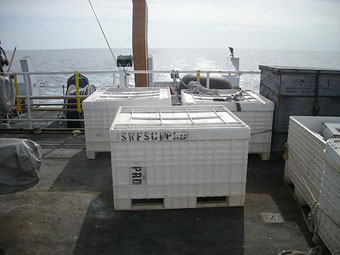

 | |||||||
|
|
Journals 2007/2008Heather Judkins
November 26, 2007 The science operations ended on Friday evening with the last CTD dropping down to 1000 m an hour after sunset. It was a great day with two different blue whale and striped dolphin sightings! Then we started the long trip home. We had approximately 1200 miles from the endpoint to our final destination, San Diego, CA. The top speed of the ship is about 11 knots and it was to take 5-6 days to return depending on weather and sea conditions. So, the packing begins. Each project team is responsible for packing up prior to docking for quick removal of all gear, equipment, and samples once in San Diego. I was assigned to help the oceanography team with inventory and packing of the large fish boxes that have been on deck for months. Once at the dock, all teams will be putting equipment into trucks for the trip to Southwest Fisheries Science Center. The helpful thing about this cruise is that because of the diamond shape transects, there is time while we are in transit back to pack. On other STAR cruises, the scientists are working until the last possible minute and there is a rush to get everything done in a timely manner. Where is the McArthur II going next? The ship and crew will be in San Diego for one to two days before departing for the shipyard in Portland, OR, where it will stay for maintenance from December through March before starting their cruise schedule for next year. The crew remains with the ship while in the shipyard but can not live on it during this time.  Profile: Marine Science Questions: 1. What method do you think is used to remove the fish boxes from the ship to shore? 2. List the steps in the scientific method. Which part am I working on while at sea? Which part does Eric work with at the lab? |
||||||